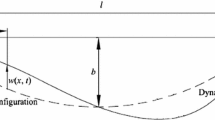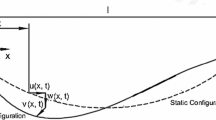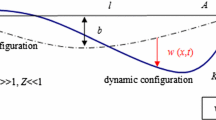Abstract
Cable’s non-planar coupled dynamics under asynchronous out-of-plane support motions is investigated in this paper. The moving boundary difficulty is coped by transforming the small support motions into two resonant boundary modulation terms, and cable’s one-to-one resonant coupled non-planar dynamics is reduced through attacking directly the continuous dynamic equations by the multiple scale method. Two boundary dynamic coefficients are derived, characterizing the boundary modulation effects, which are equal for symmetric out-of-plane modes, while opposite for asymmetric ones. Both cable’s frequency and amplitude (of support deflection) response diagrams, with phase lags between supports, are constructed using numerical continuation algorithms, and the steady-state solutions’ stability and bifurcation properties are determined, based upon which the phase lags’ effects on dynamic responses, or travelling wave effects, are thoroughly investigated, through varying the phase lags.









Similar content being viewed by others
References
Rega, G.: Nonlinear vibrations of suspended cables—part I: modeling and analysis. Appl. Mech. Rev. 57, 443–478 (2004)
Ibrahim, R.A.: Nonlinear vibrations of suspended cables—part III: random excitation and interaction with fluid flow. Appl. Mech. Rev. 57, 515–549 (2004)
Irvine, H.M., Caughey, T.K.: The linear theory of free vibrations of a suspended cable. In: Proceedings of the Royal Society of London A: Mathematical, Physical and Engineering Sciences, pp. 299–315. The Royal Society (1974)
Irvine, H.M.: Cable Structures. Dover Publications, New York (1992)
Triantafyllou, M.: Dynamics of cables, towing cables and mooring systems. Shock Vib. Dig. 23, 3–8 (1991)
Jin, D., Wen, H., Hu, H.: Modeling, dynamics and control of cable systems. Adv. Mech. 34, 304–313 (2004)
Gattulli, V., Martinelli, L., Perotti, F., Vestroni, F.: Nonlinear oscillations of cables under harmonic loading using analytical and finite element models. Comp. Methods Appl. Mech. Eng. 193, 69–85 (2004)
Xiong, W., Cai, C., Zhang, Y., Xiao, R.: Study of super long span cable-stayed bridges with CFRP components. Eng. Struct. 33, 330–343 (2011)
Hagedorn, P., Schäfer, B.: On non-linear free vibrations of an elastic cable. Int. J. Non Linear Mech. 15, 333–340 (1980)
Luongo, A., Rega, G., Vestroni, F.: Planar non-linear free vibrations of an elastic cable. Int. J. Non Linear Mech. 19, 39–52 (1984)
Benedettini, F., Rega, G.: Non-linear dynamics of an elastic cable under planar excitation. Int. J. Non Linear Mech. 22, 497–509 (1987)
Perkins, N.C.: Modal interactions in the non-linear response of elastic cables under parametric/external excitation. Int. J. Non Linear Mech. 27, 233–250 (1992)
Benedettini, F., Rega, G., Alaggio, R.: Non-linear oscillations of a four-degree-of-freedom model of a suspended cable under multiple internal resonance conditions. J. Sound Vib. 182, 775–798 (1995)
Cai, Y., Chen, S.: Dynamics of elastic cable under parametric and external resonances. J. Eng. Mech. 120, 1786–1802 (1994)
Lilien, J.-L., Da Costa, A.P.: Vibration amplitudes caused by parametric excitation of cable stayed structures. J. Sound Vib. 174, 69–90 (1994)
Costa, APd, Martins, J., Branco, F., Lilien, J.L.: Oscillations of bridge stay cables induced by periodic motions of deck and/or towers. J. Eng. Mech. 122, 613–622 (1996)
El-Attar, M., Ghobarah, A., Aziz, T.: Non-linear cable response to multiple support periodic excitation. Eng. Struct. 22, 1301–1312 (2000)
Berlioz, A., Lamarque, C.-H.: A non-linear model for the dynamics of an inclined cable. J. Sound Vib. 279, 619–639 (2005)
Georgakis, C.T., Taylor, C.A.: Nonlinear dynamics of cable stays. Part 1: sinusoidal cable support excitation. J. Sound Vib. 281, 537–564 (2005)
Wang, L., Zhao, Y.: Large amplitude motion mechanism and non-planar vibration character of stay cables subject to the support motions. J. Sound Vib. 327, 121–133 (2009)
Gonzalez-Buelga, A., Neild, S., Wagg, D., Macdonald, J.: Modal stability of inclined cables subjected to vertical support excitation. J. Sound Vib. 318, 565–579 (2008)
Guo, T.D., Kang, H.J., Wang, L.L.: A boundary modulation formulation for cable’s non-planar coupled dynamics under out-of-plane support motion. Arch. Appl. Mech. (2015). doi:10.1007/s00419-015-1058-8
Shaw, S.W., Pierre, C.: Normal modes of vibration for non-linear continuous systems. J. Sound Vib. 169, 319–347 (1994)
Nayfeh, A.H.: Nonlinear Interactions. Wiley, New York (2000)
Pakdemirli, M., Boyaci, H.: Effect of non-ideal boundary conditions on the vibrations of continuous systems. J. Sound Vib. 249, 815–823 (2002)
Ghobarah, A., Aziz, T., El-Attar, M.: Response of transmission lines to multiple support excitation. Eng. Struct. 18, 936–946 (1996)
Rega, G., Lacarbonara, W., Nayfeh, A., Chin, C.: Multiple resonances in suspended cables: direct versus reduced-order models. Int. J. Non Linear Mech. 34, 901–924 (1999)
Nayfeh, A.H., Arafat, H.N., Chin, C.-M., Lacarbonara, W.: Multimode interactions in suspended cables. J. Vib. Control 8, 337–387 (2002)
Lacarbonara, W.: Direct treatment and discretizations of non-linear spatially continuous systems. J. Sound Vib. 221, 849–866 (1999)
Nayfeh, A.H., Pai, P.F.: Linear and Nonlinear Structural Mechanics. Wiley, New York (2008)
Srinil, N., Rega, G.: The effects of kinematic condensation on internally resonant forced vibrations of shallow horizontal cables. Int. J. Non Linear Mech. 42, 180–195 (2007)
Pakdemirli, M., Nayfeh, S., Nayfeh, A.: Analysis of one-to-one autoparametric resonances in cables—discretization vs. direct treatment. Nonlinear Dyn. 8, 65–83 (1995)
Lacarbonara, W., Rega, G., Nayfeh, A.: Resonant non-linear normal modes. Part I: analytical treatment for structural one-dimensional systems. Int. J. Non Linear Mech. 38, 851–872 (2003)
Nayfeh, A.H., Balachandran, B.: Applied Nonlinear Dynamics: Analytical, Computational and Experimental Methods. Wiley, New York (2008)
Acknowledgments
This study is funded by Program for Supporting Young Investigators, Hunan University. And it is also supported by National Science Foundation of China under Grant Nos. 11502076 and 11572117.
Author information
Authors and Affiliations
Corresponding author
Appendices
Appendix 1
The suspended cable’s linear modal analysis can be found in references [3, 30]. The in-plane symmetric modes are given by
where \(c_\mathrm{i}\) is the normalization constants. And the associated eigenfrequencies are determined by
where \(\lambda ^{2}=EA/mgl(8b/l)^{3}\) is the elasto-geometric parameter. The above nonlinear transcendental equations can be solved by the Newton–Raphson method.
The in-plane anti-symmetric modes are
with the associated eigenfrequencies as
And the out-of-plane modes are
with the associated eigenfrequencies as
Appendix 2
Appendix 3
The shape functions \({\varPsi }_\mathrm{k}(x)\) are illustrated in the following, and they are used to calculate the nonlinear resonant interaction coefficients \(\Gamma _\mathrm{k}\) (Fig. 10).
Rights and permissions
About this article
Cite this article
Guo, T., Kang, H., Wang, L. et al. Cable’s non-planar coupled vibrations under asynchronous out-of-plane support motions: travelling wave effect. Arch Appl Mech 86, 1647–1663 (2016). https://doi.org/10.1007/s00419-016-1141-9
Received:
Accepted:
Published:
Issue Date:
DOI: https://doi.org/10.1007/s00419-016-1141-9





